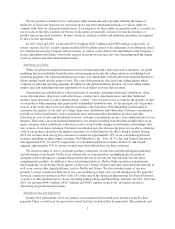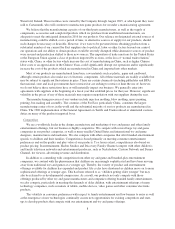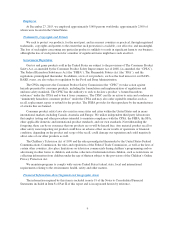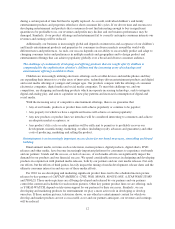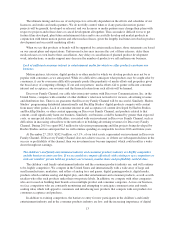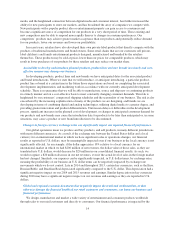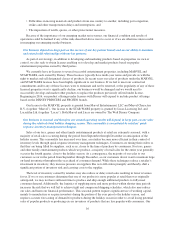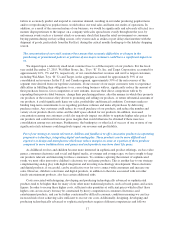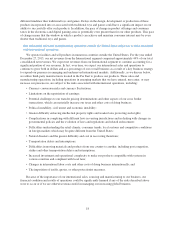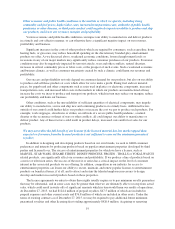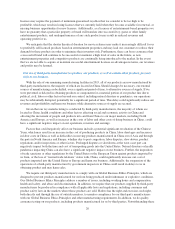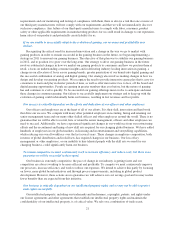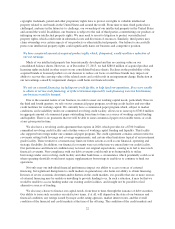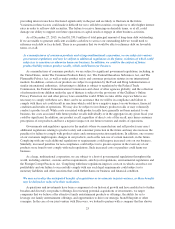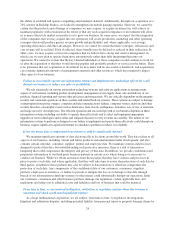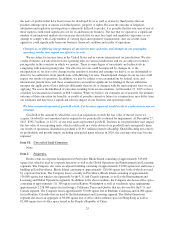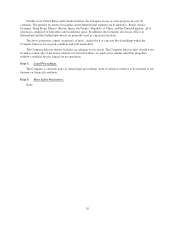Hasbro 2015 Annual Report Download - page 28
Download and view the complete annual report
Please find page 28 of the 2015 Hasbro annual report below. You can navigate through the pages in the report by either clicking on the pages listed below, or by using the keyword search tool below to find specific information within the annual report.failure to accurately predict and respond to consumer demand, resulting in our under producing popular items
and/or overproducing less popular items, would reduce our total sales and harm our results of operations. In
addition, as a result of the seasonal nature of our business, we would be significantly and adversely affected, in a
manner disproportionate to the impact on a company with sales spread more evenly throughout the year, by
unforeseen events such as a terrorist attack or economic shock that harm the retail environment or consumer
buying patterns during our key selling season, or by events such as strikes or port delays that interfere with the
shipment of goods, particularly from the Far East, during the critical months leading up to the holiday shopping
season.
The concentration of our retail customer base means that economic difficulties or changes in the
purchasing or promotional policies or patterns of our major customers could have a significant impact on
us.
We depend upon a relatively small retail customer base to sell the majority of our products. For the fiscal
year ended December 27, 2015, Wal-Mart Stores, Inc., Toys “R” Us, Inc. and Target Corporation, accounted for
approximately 16%, 9% and 9%, respectively, of our consolidated net revenues and our five largest customers,
including Wal-Mart, Toys “R” Us and Target, in the aggregate accounted for approximately 39% of our
consolidated net revenues. In the U.S. and Canada segment, approximately 59% of the net revenues of the
segment were derived from our top three customers. If one or more of our major customers were to experience
difficulties in fulfilling their obligations to us, cease doing business with us, significantly reduce the amount of
their purchases from us, favor competitors or new entrants, increase their direct competition with us by
expanding their private-label business, change their purchasing patterns, alter the manner in which they promote
our products or the resources they devote to promoting and selling our products, or return substantial amounts of
our products, it could significantly harm our sales, profitability and financial condition. Customers make no
binding long-term commitments to us regarding purchase volumes and make all purchases by delivering
purchase orders. Any customer could reduce its overall purchase of our products, and reduce the number and
variety of our products that it carries and the shelf space allotted for our products. In addition, increased
concentration among our customers could also negatively impact our ability to negotiate higher sales prices for
our products and could result in lower gross margins than would otherwise be obtained if there were less
consolidation among our customers. Furthermore, the bankruptcy or other lack of success of one or more of our
significant retail customers could negatively impact our revenues and profitability.
Part of our strategy to remain relevant to children and families is to offer innovative products incorporating
progressive technology, integrating digital and analog play. These products can be more difficult and
expensive to design and manufacture which may reduce margins on some or a portion of these products
compared to more traditional toys and games and such products may have short life spans.
As childhood evolves and children become more interested in sophisticated product offerings, such as video
games, consumer electronics and social and digital media, at younger and younger ages, we have sought to keep
our products relevant and interesting for these consumers. To continue capturing the interest of sophisticated
youth, we must offer innovative children’s electronic toy and game products. This is another key to our strategy;
complementing analog play with digital integration and investing in technology development. These electronic
and digital products, if successful, can be an effective way for us to connect with consumers and increase our
sales. However, children’s electronic and digital products, in addition to the risks associated with our other
family entertainment products, also face certain additional risks.
Costs associated with designing, developing and producing technologically advanced or sophisticated
products tend to be higher than for many of our other more traditional products, such as board games and action
figures. In order to recoup these higher costs, sufficient sales quantities at sufficient prices which reflect those
higher costs are necessary but may be constrained by heavy competition in consumer electronics and
entertainment products, and can be further constrained by difficult economic conditions meaning we can face
increased risk of not achieving sales sufficient to recover our costs. Additionally, designing, developing and
producing technologically advanced or sophisticated products requires different competencies and follows
17


